Abstract
Background: Vaccination against severe acute respiratory syndrome coronavirus 2 (SARS-CoV-2) is recommended for patients with chronic liver diseases as the vaccine can prevent and/or reduce the severity of SARS-CoV-2 infection. However, we have little information on the often-reported liver-related adverse events (LrAEs) caused by the mRNA vaccine. Methods: We retrospectively investigated the frequency and details of severe LrAEs and changes in liver function tests in patients with chronic liver diseases. Results: Among 431 patients with chronic liver diseases, 416 (96.5%) had received the SARS-CoV-2 vaccine ≥ 2 times. Among the 345 patients included in the analysis, 6 (1.7%) had severe LrAEs; 3 ascites, 2 increases in transaminases, and 1 an increase in total bilirubin. Multivariate analysis demonstrated that cirrhosis and autoimmune disease were risk factors for severe LrAEs. In contrast, the liver function reserve assessed by the Child–Pugh and ALBI scores did not markedly change after vaccination in patients with cirrhosis and/or autoimmune diseases despite a small increase in transaminase levels. Conclusion: SARS-CoV-2 mRNA vaccines, which were used in most of our patients, are safe in patients with chronic liver diseases, but the frequency of severe LrAEs is slightly increased in patients with cirrhosis and/or autoimmune diseases.
1. Introduction
Vaccines are one form of intervention to prevent or reduce the severity of coronavirus disease 2019 (COVID-19). Currently, more than 170 vaccines have been examined in clinical trials according to the WHO (https://www.gavi.org/vaccineswork/there-are-four-types-covid-19-vaccines-heres-how-they-work, accessed on 24 December 2022). Among severe acute respiratory syndrome coronavirus 2 (SARS-CoV-2) vaccines, the BNT162b2 mRNA COVID-19 vaccine showed 95% efficacy against the early spread of SARS-CoV-2, regardless of age or the presence of coexisting conditions [1,2]. Other vaccines, including non-replicating viral-vector, protein-based, and inactivated-virus vaccines, also showed high efficacy [3]. Although there were serious adverse events reported after vaccination, the incidence was extremely low [4]. In Japan, the COVID-19 vaccination program started in February 2021, and more than 102 million people (81.0%) had received ≥2 doses as of 9 August 2022 (https://www.kantei.go.jp/jp/headline/kansensho/vaccine.html, accessed on 10 August 2022). Among COVID-19 vaccines, mRNA vaccines are the most frequently used in Japan as they are the type provided by the Japanese government. The Japanese government is actively promoting a vaccination campaign to prevent the spread of SARS-CoV-2 infection.
While an early international phase 2/3 trial demonstrated that mRNA vaccines for SARS-CoV-2 were safe and effective in the general population as well as patients, the number of patients with chronic liver disease included in that trial was limited. Subsequent studies demonstrated that an inactivated vaccine for SARS-CoV-2 was safe and effective in patients with chronic liver disease [5,6]. Most adverse events (AEs) were self-limiting, including pain at the injection site, muscle pain, a fever, and fatigue. Thus, a number of liver-related medical associations published position papers recommending patients with chronic liver diseases receive the vaccine [7,8]. Indeed, vaccination reduced the rate of death or hospitalization in patients with liver cirrhosis [9]. Thus, patients with chronic liver diseases should receive the vaccine.
However, a number of these patients have declined to receive the vaccine out of fear of AEs [10]. Indeed, there have been reports of liver dysfunction being noted after vaccination (https://covid-vaccine.jp/, accessed on 10 August 2022). In addition, there were patients who developed autoimmune hepatitis after vaccination [11,12,13]. Furthermore, some patients with compensated liver cirrhosis progressed to decompensated cirrhosis after vaccination [11]. Indeed, we have often encountered patients with chronic liver diseases who showed further liver dysfunction after receiving the vaccine. At present, little information is available on liver-related AEs (LrAEs), including decompensated events, in patients with chronic liver disease after vaccination, particularly with mRNA vaccines. In addition, little information is available concerning the frequency of vaccination among these patients.
We, therefore, aimed to investigate the frequency of severe LrAEs and changes in liver function tests after vaccination in patients with chronic liver diseases because these data have not yet been published.
2. Results
2.1. High Vaccination Rate in Patients with Chronic Liver Diseases in Our Hospital
Among 431 patients with chronic liver diseases, 416 (96.5%) received the COVID-19 vaccine ≥ 2 times (Table 1). The remaining 15 patients did not receive the vaccine. The frequencies of vaccination in Japan and Tochigi prefecture were 81.0% (102,552,912/126,645,025) and 82.7% (1,616,720/1,955,401), respectively. The frequency of vaccination in our patient group was higher than those in a nationwide survey (p < 0.001) and Tochigi Prefecture (p < 0.001), where our university hospital is located. In addition, the frequency of vaccination in each generation was higher than those in nationwide and prefectural surveys. Furthermore, the presence of hepatocellular carcinoma (HCC), liver cirrhosis, autoimmune diseases, or background liver disease did not markedly influence the vaccination rate (Table S1).

Table 1.
The frequency of patients who received vaccine two times or more in each generation.
2.2. Liver Cirrhosis and Autoimmune Diseases as Risk Factors for Severe LrAEs after Vaccination
Among the 416 patients who received the vaccine, we investigated 345, as 71 had data loss and/or deterioration of the primary liver disease. The median age was 66 years old. There were 125, 65, and 92 patients who had cirrhosis, a history of HCC, and autoimmune diseases, respectively (Table 2). Approximately 80% of vaccines were provided by Pfizer.

Table 2.
Background of patients.
After vaccination, 226 patients (65.5%) complained of any symptomatic AEs, including pain at the injection site, fatigue, and a fever. Most of them were grade 1 and self-limited. However, no patients reported severe extrahepatic manifestations, including thrombotic thrombocytopenia, immune thrombocytopenic purpura, or Guillain–Barre syndrome. Six patients (1.7%) had severe LrAEs (≥grade 3) after vaccination (Table 3).

Table 3.
Details of patients who had severe LrAEs.
Among these six patients, five had liver cirrhosis. One patient in the non-cirrhosis group had autoimmune hepatitis. Multivariable analysis showed that liver cirrhosis and the presence of autoimmune diseases were independent factors for severe LrAEs (Table 4).

Table 4.
Univariable and multivariable analyses for severe LrAEs.
However, autoimmune hepatitis itself was not a risk factor in a re-analysis of multivariable analyses (data not shown). In addition, a history of HCC and the presence of symptomatic AEs were not risk factors for severe LrAEs. Furthermore, the frequency of severe LrAEs tended to be higher in patients with advanced liver cirrhosis than in those with less advanced cirrhosis (Table 5).

Table 5.
The number of severe LrAEs in patients with cirrhosis.
2.3. Association between Vaccination and the Liver Function Reserve in Patients with Liver Cirrhosis
Because liver cirrhosis was a risk factor for severe LrAEs, we investigated the effect of vaccination on the liver function reserve, including the Child–Pugh (CP) and albumin-bilirubin (ALBI) scores, in the patient with liver cirrhosis. There were no significant changes in the CP score after vaccination (Figure 1a, left). In addition, the vaccine did not worsen CP scores when cirrhotic patients were divided into compensated (CP class A) and decompensated groups (CP classes B/C) (Figure 1a, middle) and less severe (ALBI grade 1/2a) and severe cirrhosis groups (ALBI grade 2b/3) (Figure 1a, right). Furthermore, the vaccine did not worsen the ALBI score in patients with liver cirrhosis (Figure 1b).
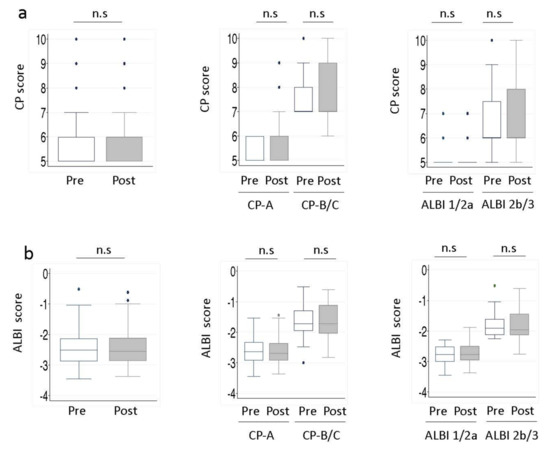
Figure 1.
Changes in the liver function reserve after vaccination. (a) Child–Pugh (CP) score in all patients with cirrhosis (left, n = 111), CP class A (n = 91) and B/C (n = 20) (middle), and ALBI grade 1/2a (n = 82) and 2b/3 (n = 42) (right). (b) Liver function reserve as assessed by the ALBI score in all patients with cirrhosis before and after vaccine (left, n = 124), CP class A and B/C (middle), and ALBI grade 1/2a and 2b/3 (right). n.s.: not significant.
In analyses of each component of CP and ALBI scores, the serum albumin levels remained unchanged, regardless of the liver function reserve (Figure 2a). The total bilirubin levels were elevated after vaccination, with an increase of 0.05 mg/dl in the median value. This elevation in total bilirubin was noted in the CP class B/C group (Figure 2b, middle). In contrast, the prothrombin time (PT) was improved in patients with CP class A or ALBI 1/2a groups assessed by the international normalized ratio (INR) (Figure 2c).
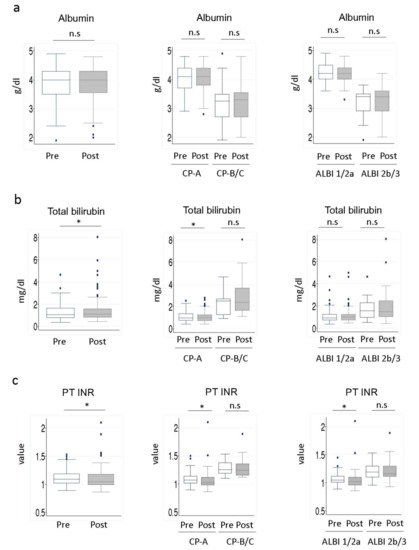
Figure 2.
Changes in serum albumin ((a), n = 124), total bilirubin ((b), n = 125), and prothrombin-time INR ((c), n = 110) after vaccination in patients with cirrhosis. All patients are shown in the left panel, CP class A (n = 91) and B/C (n = 20) are shown in the middle panel, and ALBI grade 1/2a (n = 82) and 2b/3 (n = 42) are shown in the right panel. *: p < 0.05, n.s.: not significant.
Both the aspartate aminotransferase (AST) and alanine aminotransferase (ALT) levels were elevated in patients with cirrhosis after vaccination. However, the increases in AST and ALT were 2 IU/L and 3 IU/L in the median value, respectively (Figure 3a,b).
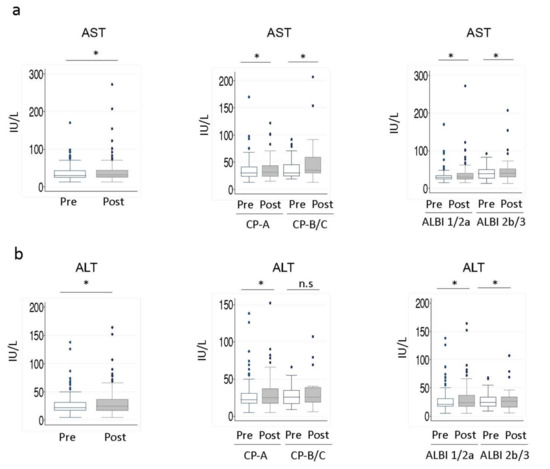
Figure 3.
Changes in serum AST ((a), n = 125) and ALT ((b), n = 125) levels after vaccination in patients with cirrhosis. All patients are shown in the left panel, CP class A (n = 91) and B/C (n = 20) are shown in the middle panel, and ALBI grade 1/2a (n = 82) and 2b/3 (n = 42) are shown in the right panel. *: p < 0.05, n.s.: not significant.
2.4. Vaccination Effects on the Liver Function Tests in Patients with Autoimmune Diseases
We then investigated LrAEs in patients with autoimmune diseases. The trends in liver function tests were similar to those in patients with cirrhosis, with no change in albumin levels and an improvement in PT. Elevations were noted in the total bilirubin, AST, and ALT levels, with median values of 0.02 mg/dl, 0 IU/L, and 1.5 IU/L, respectively (Figure 4).
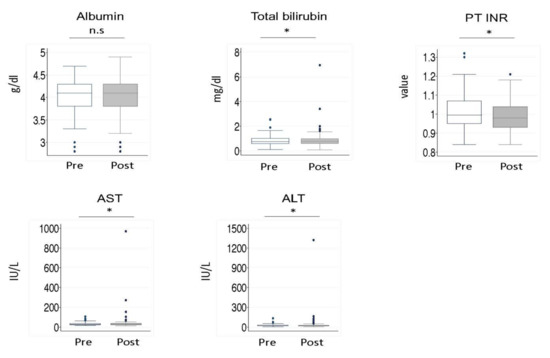
Figure 4.
Changes in serum albumin (n = 91), total bilirubin (n = 91), prothrombin-time INR (n = 54), AST (n = 92), and ALT (n = 92) levels after vaccination in patients with autoimmune diseases. *: p < 0.05, n.s.: not significant.
We then focused on these liver function tests in patients with both cirrhosis and autoimmune diseases. The liver function reserve did not markedly change, regardless of the presence of autoimmune diseases. Although the transaminase levels were slightly increased, other test values were not changed (Figure 5).
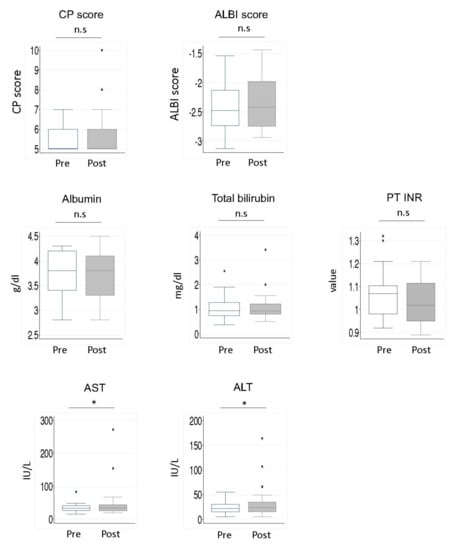
Figure 5.
Changes in liver function reserve, serum albumin, total bilirubin, prothrombin-time INR, AST, and ALT levels after vaccination in patients with both cirrhosis and autoimmune diseases (n = 28). *: p < 0.05, n.s.: not significant.
2.5. Vaccination Effects on Liver Function Tests in Noncirrhotic Patients
In noncirrhotic patients, the serum albumin and PT levels improved after vaccination. The transaminase and bilirubin levels did not markedly change (Figure 6).
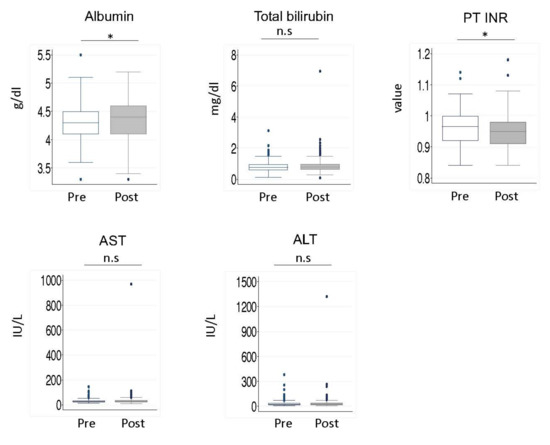
Figure 6.
Changes in serum albumin (n = 218), total bilirubin (n = 216), prothrombin-time INR (n = 102), AST (n = 220), and ALT (n = 220) levels after vaccination in non-cirrhotic patients. *: p < 0.05, n.s.: not significant.
3. Discussion
We showed that the frequency of vaccination among patients with chronic liver disease in our hospital was high compared to the general population in a nationwide survey. While the frequency of severe LrAEs was high in patients with liver cirrhosis or autoimmune diseases, vaccination was shown to have little effect on the liver function in patients with chronic liver diseases.
In the present study, liver cirrhosis was a risk factor for severe LrAEs. Patients with liver cirrhosis are vulnerable to insults. Thus, it is not surprising that LrAEs occur in patients with liver cirrhosis, particular in those with decompensated cirrhosis, after vaccination. Vaccines can cause a fever and muscle pain, which may decrease the activity of patients with decompensated cirrhosis. We demonstrated that the frequency of severe LrAEs was 4.0% (5/125) among cirrhotic patients after carefully ruling out other causes of events. Although few reports have described decompensation events after COVID-19 vaccination, we speculate that decompensated events have been substantially happening in patients with liver cirrhosis. However, vaccination did not worsen the liver function reserve. We further showed that 0.8% (1/125) of patients with liver cirrhosis showed grade 3 ALT elevation, although ALT levels were only slightly elevated after vaccination in patients with cirrhosis in our study. Ai et al. reported that the frequency of grade 3 ALT elevation in cirrhotic patients (1.2%, 1/82) was not higher than that in noncirrhotic patients (2.4%, 2/82). Wong et al. reported that 0.3% (1/363) of patients with cirrhosis showed grade 3 ALT elevation. Although there may be some differences in AEs between mRNA vaccines (our study) and inactivated vaccines (Ai et al., Wang et al.), the frequency of grade 3 ALT elevation was not high in patients with cirrhosis.
Autoimmune disease was another risk factor for severe LrAEs in the present study. Immunological diseases, including autoimmune hepatitis, have been reported to occur after mRNA vaccines [11,12,13]. Among six patients with severe LrAEs, four had autoimmune diseases, including autoimmune hepatitis. There is an association between vaccines and autoimmune diseases. One possible mechanism by which vaccines induce autoimmune diseases is production of type I interferon (IFN) [14]. mRNA can act as a ligand for toll-like receptor (TLR) 3 and TLR7 [15], which activate the signaling of Type I IFN production. Type I IFN can regulate the immune system involvement of lymphocytes [15]. There are several types of vaccines against SARS-CoV2, including inactivated SARS-CoV2 and mRNA vaccines. These types of vaccine both have the potential to induce type I IFN, as TLR can recognize the components of the virus. This is not specific for COVID-19 vaccines; indeed, the HBV vaccine has also been reported to induce the development of autoimmune diseases [16]. Although the frequency of autoimmune disease induced by vaccine is not always high, autoimmune diseases may occur under the current vaccination program.
We also examined whether or not patients with two risk factors, cirrhosis and autoimmune diseases, are particularly prone to liver dysfunction. However, vaccination did not worsen the liver function reserve in these patients. Although autoimmune disease was a risk factor for severe LrAEs, autoimmune hepatitis itself was not a risk factor in our study. Most patients with autoimmune diseases in our study had been treated with immunosuppressive drugs, including prednisolone. In contrast, the two patients were found to have autoimmune hepatitis after vaccination; they had no specific treatment before vaccination. Thus, it is possible that the vaccine induced autoimmune hepatitis. Of note, immunosuppressive drugs may prevent further liver dysfunction in patients with autoimmune hepatitis. Indeed, there were no patients who showed the exacerbation of autoimmune disease after vaccine. Therefore, it is difficult to determine before vaccination which patients will likely develop severe LrAEs after vaccination.
A couple of limitations associated with the present study warrant mentioning. The present study was retrospective, so the date of blood testing following the second vaccination varied among patients. Thus, some patients may have recovered from their liver dysfunction by the time they underwent a blood test. In addition, the present study was a single-center study. Thus, there may be some bias with regard to the patient’s background characteristics. However, 96.5% of the patients in this study received the vaccines, and these patients all had various disease backgrounds. In addition, all generations showed a high frequency of vaccination compared to the results of a Japanese Government survey. Thus, our study was considered to have covered the whole population of patients who visited our hospital. The main reason for no vaccination in 15 patients was fear of AEs, which was the same reason in a survey of patients with cancers performed in the USA [17].
We first demonstrated the frequency of severe LrAEs and changes in liver function tests in patients with chronic liver disease. Vaccination reduced the rate of death or hospitalization in patients with liver cirrhosis [9]. In addition, a third dose of vaccination appears to overcome vaccine hyporesponsiveness in patients with cirrhosis [18]. Thus, our data will promote the vaccination campaign for those who are hesitant to receive vaccines.
4. Materials and Methods
4.1. Design
This was a retrospective single-center study. The primary and secondary endpoints were to determine the frequency of severe LrAEs and changes in liver function tests, respectively, in patients with chronic liver disease. A minimum sample size calculated by 80% power at a significance level of 5% was at least 176 patients. A non-probable sampling method was used in the present study. We reviewed 345 patients who were finally analyzed in the present study. These 345 patients had no liver dysfunction ≥ grade 3 level for 6 months until the vaccine. Our null hypothesis was “COVID-19 vaccine does not induce grade 3 liver dysfunction”. We denied our null hypothesis because the Chi-square was 6.05, which was over 3.84. Thus, there is the possibility that COVID-19 vaccines induce grade 3 liver dysfunction. We did not set up a prediction model in the present study. Point estimation was used in the performance evaluation of the estimates and a randomized search was used to optimize the hyperparameter.
4.2. Patients
A total of 431 patients with chronic liver disease reported details concerning their COVID-19 vaccination status when they visited our hospital between 1 April and 31 July, 2022. The information included the date of vaccine, provider, and AEs. None of the participants had COVID-19 before receiving the second injection of the vaccine. Among 431 patients, 15 had not received the vaccine. An addition 71 patients were excluded from the final analyses due to following reasons: missing data, interventions for diseases, deterioration of primary liver disease, and the possibility of drug-induced liver injury.
The diagnosis of liver cirrhosis was made by chief physicians based on imaging studies and laboratory data. Clinical and laboratory data before and after vaccinations were obtained from medical records. The pre-and post-vaccine data were within six months before the first vaccine and three months after the second vaccine, respectively. AEs were determined according to the CTCAE ver5. LrAEs included changes in levels of transaminase, total bilirubin, albumin, PT, ascites, and hepatic encephalopathy. Because it was difficult to distinguish between grade 1 AEs and the deterioration of primary liver disease, we noted ≥ grade 3 liver dysfunction according to CTCAE ver5. Autoimmune diseases in the present study included the following diseases: rheumatoid arthritis, Basedow’s disease, Hashimoto’s disease, autoimmune hepatitis, primary biliary cholangitis, autoimmune hemolytic anemia, Sjogren’s syndrome, eosinophilic granulomatosis with polyangiitis, Erythema multiforme, systemic lupus erythematosus, sacroiliac joint disease, mixed connective tissue disease, psoriasis vulgaris, Behcet’s disease, and autosensitization dermatitis. The present study was approved by the ethics committee of Jichi Medical University Hospital (Fiver version 22-023).
5. Statistical Analyses
All statistical analyses were performed using the STATA/Basic Edition version 17.0 software program, licensed to Oyunjargal Bat-Erdene (STATA Corporation, College Station, TX, USA). Statistical analyses were performed using the t-test or Mann–Whitney U-test, Chi-square test, or Wilcoxson matched-pairs signed-rank test. A p-value of < 0.05 was considered statistically significant.
6. Conclusions
COVID-19 mRNA vaccines are safe to administer to patients with chronic liver disease, although the frequency of severe LrAEs is slightly higher in patients with liver cirrhosis or autoimmune diseases.
Supplementary Materials
The following supporting information can be downloaded at: https://www.mdpi.com/article/10.3390/gidisord5010002/s1, Table S1: The frequency of patients who received vaccine.
Author Contributions
Conceptualization, K.M. and N.M.; Methodology, K.M. and N.M.; Software, H.M. and K.M.; Validation, K.M. and N.M.; Formal Analysis, H.M. and K.M.; Investigation, O.B.-E., K.M., H.M., S.W., M.T., Y.T., H.N., R.G. and N.M.; Resources, K.M. and N.M.; Data Curation, K.M.; Writing—Original Draft Preparation, O.B.-E.; Writing—Review and Editing, K.M. and N.M.; Visualization, K.M.; Supervision, H.Y.; Project Administration, K.M.; Funding Acquisition, No funding. All authors have read and agreed to the published version of the manuscript.
Funding
This research received no external funding.
Institutional Review Board Statement
The study was conducted according to the guidelines of the Declaration of Helsinki and approved by the ethics committee of the Jichi Medical University Hospital (20-175, approved on 2 July 2021; revised version 22-023 was approved on 4 July 2022).
Informed Consent Statement
Written informed consent was waived due to the nature of the study (retrospective study). Instead, we show an opt-out document on our University Website (https://www.jichi.ac.jp) for patients who want to reject the entry to the present study and publication of the paper, according to the ethics committee of the Jichi Medical University Hospital.
Data Availability Statement
The data used in the present study are available from corresponding author upon reasonable request.
Acknowledgments
We thank Eri Noguchi and Kazuhiko Kotani, Jichi Medical University, for their support in collecting data and in statistical analysis, respectively. E.N. and K.K. have consented to the acknowledgement.
Conflicts of Interest
H.Y. received honoraria from Pfizer and Takeda. These companies had no role in the design, execution, interpretation, or writing of the study. Other authors declare no conflicts of interest.
References
- Polack, F.P.; Thomas, S.J.; Kitchin, N.; Absalon, J.; Gurtman, A.; Lockhart, S.; Perez, J.L.; Pérez Marc, G.; Moreira, E.D.; Zerbini, C.; et al. Safety and efficacy of the BNT162b2 mRNA COVID-19 vaccine. N. Engl. J. Med. 2020, 383, 2603–2615. [Google Scholar] [CrossRef] [PubMed]
- Thomas, S.J.; Moreira, E.D., Jr.; Kitchin, N.; Absalon, J.; Gurtman, A.; Lockhart, S.; Perez, J.L.; Pérez Marc, G.; Polack, F.P.; Zerbini, C.; et al. Safety and Efficacy of the BNT162b2 mRNA Covid-19 Vaccine through 6 Months. N. Engl. J. Med. 2021, 385, 1761–1773. [Google Scholar] [CrossRef] [PubMed]
- Fiolet, T.; Kherabi, Y.; MacDonald, C.-J.; Ghosn, J.; Peiffer-Smadja, N. Comparing COVID-19 vaccines for their characteristics, efficacy and effectiveness against SARS-CoV-2 and variants of concern: A narrative review. Clin. Microbiol. Infect. 2022, 28, 202–221. [Google Scholar] [CrossRef]
- Schinas, G.; Polyzou, E.; Mitropetrou, F.; Pazionis, A.; Gogos, C.; Triantos, C.; Akinosoglou, K. COVID-19 Vaccination in Patients with Chronic Liver Disease. Viruses 2022, 14, 2778. [Google Scholar] [CrossRef]
- Wang, J.; Zhang, Q.; Ai, J.; Liu, D.; Liu, C.; Xiang, H.; Gu, Y.; Guo, Y.; Lv, J.; Huang, Y.; et al. Safety and immunogenicity of SARS-CoV-2 vaccines in Chinese patients with cirrhosis: A prospective multicenter study. Hepatol. Int. 2022, 16, 691–701. [Google Scholar] [CrossRef]
- Ai, J.; Wang, J.; Liu, D.; Xiang, H.; Guo, Y.; Lv, J.; Zhang, Q.; Li, J.; Zhang, X.; Li, Q.; et al. Safety and Immunogenicity of SARS-CoV-2 Vaccines in Patients With Chronic Liver Diseases (CHESS-NMCID 2101): A Multicenter Study. Clin. Gastroenterol. Hepatol. 2022, 20, 1516–1524.e2. [Google Scholar] [CrossRef] [PubMed]
- Fix, O.K.; Blumberg, E.A.; Chang, K.-M.; Chu, J.; Chung, R.T.; Goacher, E.K.; Hameed, B.; Kaul, D.R.; Kulik, L.M.; Kwok, R.M.; et al. American Association for the Study of Liver Diseases Expert Panel Consensus Statement: Vaccines to Prevent Coronavirus Disease 2019 Infection in Patients with Liver Disease. Hepatology 2021, 74, 1049–1064. [Google Scholar] [CrossRef] [PubMed]
- Cornberg, M.; Buti, M.; Eberhardt, C.S.; Grossi, P.A.; Shouval, D. EASL position paper on the use of COVID-19 vaccines in patients with chronic liver diseases, hepatobiliary cancer and liver transplant recipients. J. Hepatol. 2021, 74, 944–951. [Google Scholar] [CrossRef] [PubMed]
- John, B.V.; Deng, Y.; Scheinberg, A.; Mahmud, N.; Taddei, T.H.; Kaplan, D.; Labrada, M.; Baracco, G.; Dahman, B. Association of BNT162b2 mRNA and mRNA-1273 Vaccines With COVID-19 Infection and Hospitalization Among Patients With Cirrhosis. JAMA Intern. Med. 2021, 181, 1306–1314. [Google Scholar] [CrossRef] [PubMed]
- Cao, Z.; Zhang, C.; Zhao, S.; Sheng, Z.; Xiang, X.; Li, R.; Qian, Z.; Wang, Y.; Bin Chen, B.; Li, Z.; et al. COVID-19 vaccines in patients with decompensated cirrhosis: A retrospective cohort on safety data and risk factors associated with unvaccinated status. Infect. Dis. Poverty 2022, 11, 56. [Google Scholar] [CrossRef] [PubMed]
- Shroff, H.; Satapathy, S.K.; Crawford, J.M.; Todd, N.J.; VanWagner, L.B. Liver injury following SARS-CoV-2 vaccination: A multicenter case series. J. Hepatol. 2022, 76, 211–214. [Google Scholar] [CrossRef] [PubMed]
- Izagirre, A.; Arzallus, T.; Garmendia, M.; Torrente, S.; Castiella, A.; Zapata, E.M. Autoimmune hepatitis following COVID-19 vaccination. J. Autoimmun. 2022, 132, 102874. [Google Scholar] [CrossRef] [PubMed]
- Zheng, H.; Zhang, T.; Xu, Y.; Lu, X.; Sang, X. Autoimmune hepatitis after COVID-19 vaccination. Front. Immunol. 2022, 13, 1035073. [Google Scholar] [CrossRef] [PubMed]
- Chen, Y.; Xu, Z.; Wang, P.; Li, X.; Shuai, Z.; Ye, D.; Pan, H. New-onset autoimmune phenomena post-COVID-19 vaccination. Immunology 2022, 165, 386–401. [Google Scholar] [CrossRef] [PubMed]
- Kawai, T.; Akira, S. Toll-like Receptors and Their Crosstalk with Other Innate Receptors in Infection and Immunity. Immunity 2011, 34, 637–650. [Google Scholar] [CrossRef] [PubMed]
- Segal, Y.; Shoenfeld, Y. Vaccine-induced autoimmunity: The role of molecular mimicry and immune crossreaction. Cell. Mol. Immunol. 2018, 15, 586–594. [Google Scholar] [CrossRef] [PubMed]
- Shulman, R.M.; Weinberg, D.S.; Ross, E.A.; Ruth, K.; Rall, G.F.; Olszanski, A.J.; Helstrom, J.; Hall, M.J.; Judd, J.; Chen, D.Y.; et al. Adverse Events Reported by Patients With Cancer After Administration of a 2-Dose mRNA COVID-19 Vaccine. J. Natl. Compr. Cancer Netw. 2022, 20, 160–166. [Google Scholar] [CrossRef] [PubMed]
- John, B.V.; Ferreira, R.D.; Doshi, A.; Kaplan, D.E.; Taddei, T.H.; Spector, S.A.; Paulus, E.; Deng, Y.; Bastaich, D.; Dahman, B. Third dose of COVID-19 mRNA vaccine appears to overcome vaccine hyporesponsiveness in patients with cirrhosis. J. Hepatol. 2022, 77, 1349–1358. [Google Scholar] [CrossRef] [PubMed]
Disclaimer/Publisher’s Note: The statements, opinions and data contained in all publications are solely those of the individual author(s) and contributor(s) and not of MDPI and/or the editor(s). MDPI and/or the editor(s) disclaim responsibility for any injury to people or property resulting from any ideas, methods, instructions or products referred to in the content. |
© 2023 by the authors. Licensee MDPI, Basel, Switzerland. This article is an open access article distributed under the terms and conditions of the Creative Commons Attribution (CC BY) license (https://creativecommons.org/licenses/by/4.0/).